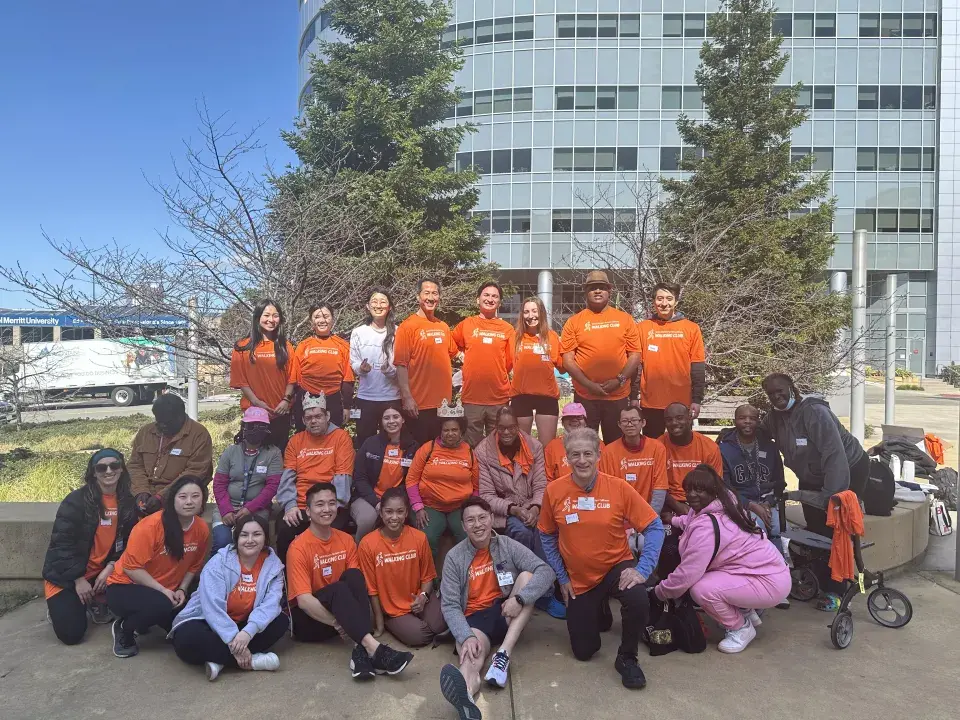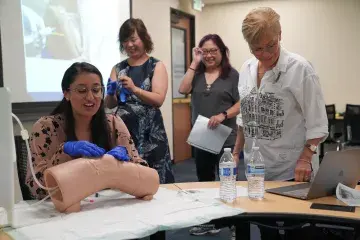Healthy Strides: Partnering with Special Olympics Northern California

As anticipation builds for the upcoming Olympic Games in Paris, a different kind of athletic fervor is palpable here in Northern California. Special Olympics athletes are eagerly preparing to showcase their skills and determination in their own sporting events.
Samuel Merritt University plays an important role in their preparation, offering two innovative programs that support these athletes with intellectual disabilities. In the process, SMU students gain invaluable learning experiences while ensuring local Special Olympics athletes have healthy habits — and for many, the right shoes — to succeed in their games.
“Our athletes often face barriers to accessing fitness and healthcare,” says Matt Cohen, chief program officer of Special Olympics Northern California (SONC), which leads free year-round training and competitions in 11 sports. “The programs and screenings offered through our partnership with SMU help to break down these barriers.”
Through the Fit Feet program, SMU podiatry and physical therapy students and faculty provide detailed foot and ankle screenings at SONC’s Healthy Athletes program events, which offer free health screenings and education spanning eight disciplines, including podiatry, physical therapy, vision, and dentistry. SMU students and faculty hold Fit Feet screenings about twice a year, so far serving more than a thousand SONC athletes since 2016.
“Fit Feet is part of the Healthy Athletes program, which is a great training ground for all of SMU’s discipline areas: nursing, physical therapy, occupational therapy, physician assistant, and podiatry programs,” says Tim Dutra, DPM, assistant professor at SMU’s College of Podiatric Medicine and longtime medical staff volunteer and clinical director of SONC’s Healthy Athletes program.
“We look for any problems or abnormalities in the athlete’s lower extremities, their legs, knees, ankles, and feet,” Dutra explains. “We check for many things, including range of motion in their joints, muscle strength, gait evaluation, skin problems, circulation, and nerve conditions. We also recommend the right footwear based on their Fit Feet exam and specific sport or activity, and make sure they are ready for their sporting events and poised to live a healthy lifestyle all year round.”
The SONC x SMU Walking Club, which meets twice a week on SMU’s campus, also brings together podiatry and physical therapy students as they encourage athletes to get more exercise, especially during their sport’s off-season. The walking club originated last fall when Stephen Hill, PhD, associate professor and manager of SMU’s Motion Analysis Research Center, received a grant from Brooks Running that outfitted 50 participants with shoes, shirts, shorts, and sports bras. Not long after they first took the new gear out for a walk together, students and faculty formalized the walking club and welcomed about 20 athletes, more than 25 SMU physical therapy and podiatry students, and other community members to walk and move together each week. “It is a pleasure to share the invigorating feeling of group exercise and the feeling of accomplishment,” says Hill.
At the Fit Feet clinics, SMU students see a diverse population of patients with unusual medical issues and gait abnormalities, says Dutra, who works alongside Hill at the clinics. “Fit Feet is a great opportunity for our students to have hands-on experience to use and reinforce the skills we’ve been teaching them in class. They’re developing their interpersonal skills and learning how to be more clear, patient, and confident when working with intellectually challenged patients.”
“There’s magic in being able to meet capable, ambitious students from other programs at SMU. It helps me see how I’m part of something bigger than my physical therapy department,” says Jason Lau, DPT ’25, one of the student leaders of the walking club. “While I’m training to be a physical therapist, it helps me understand what podiatrists can do and how we both fit into the healthcare field.”
Lau has seen changes in Special Olympics athletes in just the few months since the walking club started. “There are a lot of health and fitness improvements, as well as community building,” he says. “We started by walking one lap around the block, and now we’re going faster and farther. We’re up to three laps and we push the intensity. It’s also great to see reserved athletes who started out timid and are now coming out of their shell and moving more.”


